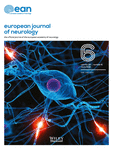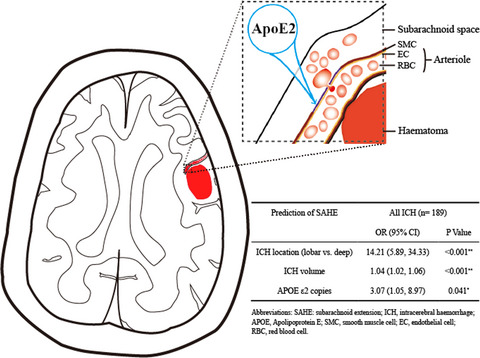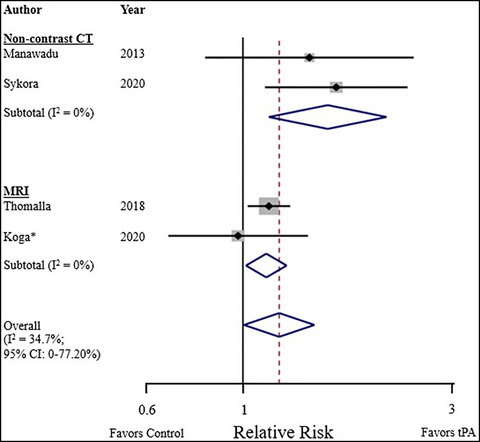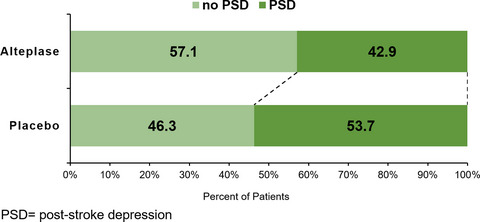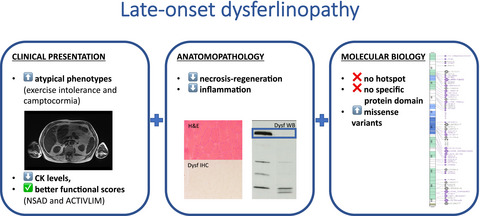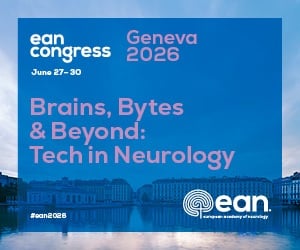Journal list menu
Export Citations
Download PDFs
Issue Information
Dementia and cognitive disorders
The challenge of detecting cognitive impairment in hearing-impaired individuals
- Pages: 1795-1796
- First Published: 07 March 2021
Stroke
Progress towards optimizing blood pressure control after reperfusion therapy for acute ischemic stroke
- Pages: 1797-1798
- First Published: 09 March 2021
Post-stroke depression: Can intravenous thrombolysis be effective?
- Pages: 1799-1800
- First Published: 29 March 2021
All neurologists
First symptom guides diagnosis and prognosis in neurodegenerative diseases—a retrospective study of autopsy proven cases
- Pages: 1801-1811
- First Published: 04 March 2021
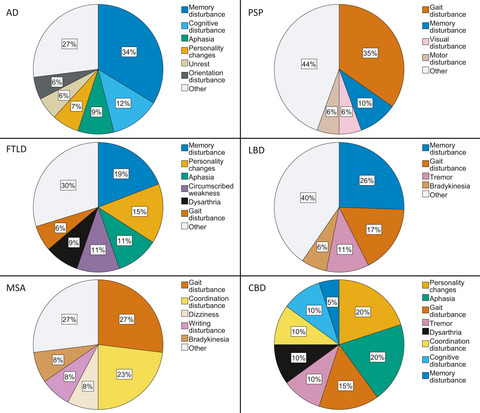
In this work, the distribution of first clinical symptoms in neurodegenerative diseases is provided together with a prevalence adjusted model that depicts the probabilities for each neurodegenerative diagnosis if a distinct first symptom occurs in a patient. For clinicians that hover between two neurodegenerative diagnoses, a scheme is given that may facilitate diagnosis using the first clinical symptom. Further, the prognostic value of the first clinical symptom regarding survival in neurodegenerative diseases is analyzed.
Somatic symptoms have negligible impact on Patient Health Questionnaire-9 depression scale scores in neurological patients
- Pages: 1812-1819
- First Published: 13 March 2021
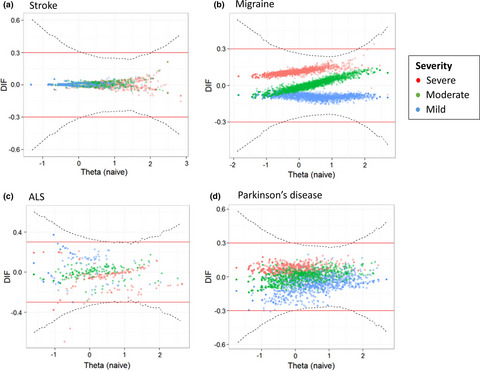
There is concern that the Patient Health Questionnaire-9 (PHQ-9) depression scale may be impacted by the presence of somatic symptoms in patients with neurological conditions, and thus result in an overidentification of patients at high risk for having depression. We evaluated the PHQ-9 for the presence and impact of differential item functioning (DIF), and found PHQ-9 items function consistently across disease severity. Salient levels of DIF impact occurred for a very small proportion of people (15/15,795). These results suggest the PHQ-9 provides a consistent measure of depression severity among people with neurological conditions associated with somatic symptoms that overlap with depression.
Dementia and cognitive disorders
Adaption and preliminary validation of the Addenbrooke's Cognitive Examination-III as a screening test for mild cognitive impairment and dementia in hearing-impaired individuals
- Pages: 1820-1828
- First Published: 23 January 2021
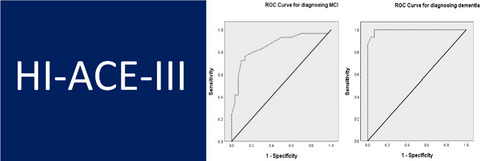
A hearing-impaired version of the Addenbrooke's Cognitive Examination-III (HI-ACE-III) was developed to address the potential impact of hearing loss on the accuracy of cognitive screening. Preliminarily, the HI-ACE-III showed good reliability, validity and screening utility for mild cognitive impairment and dementia in older adults in a hearing-impairment context. The adapted HI-ACE-III may offer more reliable indications of cognitive performance, supporting timely diagnosis and contributing to research examining links between hearing loss and cognitive decline.
The effect of intracranial stenosis on cognitive decline in a memory clinic cohort
- Pages: 1829-1839
- First Published: 25 February 2021
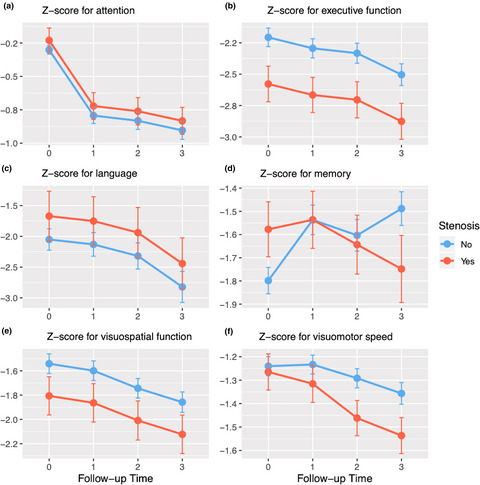
The prevalence of ICS in our memory clinic cohort was 18.1%. ICS was associated with worse executive function across all time points, and cognitive decline in memory and visuomotor speed over 3-year follow-up; these results were independent of demographic characteristics, baseline diagnosis, vascular risk factors, and other markers of cerebrovascular disease. This suggests that ICS may be a useful indicator of vascular brain damage leading to cognitive decline and may warrant consideration of antiatherosclerotic treatment in clinical trials.
Antiherpetic medication and incident dementia: Observational cohort studies in four countries
- Pages: 1840-1848
- First Published: 03 March 2021
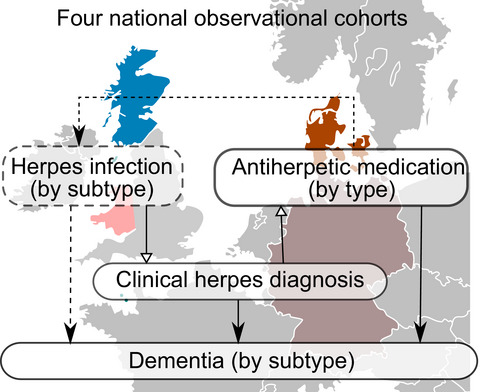
We conducted a multicenter observational cohort study using health registry data from Wales, Germany, Scotland, and Denmark to investigate potential associations between antiherpetic medication and incident dementia, broken down according to medication type and dose, type of herpes virus, and dementia subtype. Our results were heterogeneous, with a tendency toward decreased dementia risk in individuals exposed to antiherpetic medication. We conclude that short-term antiherpetic medication is not markedly associated with incident dementia.
Vitamin D and white matter hyperintensities: results of the population-based Heinz Nixdorf Recall Study and 1000BRAINS
- Pages: 1849-1858
- First Published: 08 March 2021
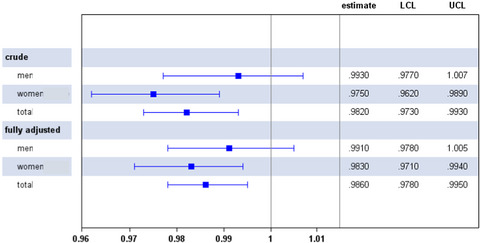
The figure shows the results of univariate and multiple linear regression to investigate the association between deseasonalized baseline 25-hydroxyvitamin D (25OHD) and white matter hyperintensities (WMHs) at 10-year follow-up in the Heinz Nixdorf Recall Study plus 1000BRAINS (LCL, lower confidence limit; UCL, upper confidence limit). In the fully adjusted model that included all participants, on average a 25OHD increase of 1 ng/ml was associated with a reduced WMH volume by a factor of 0.986 (95% CI 0.978; 0.995). In conclusion, a lower baseline 25OHD might be a weak risk factor for more pronounced WMHs 10 years later.
Risk factors for the progression of motoric cognitive risk syndrome to dementia: Retrospective cohort analysis of two populations
- Pages: 1859-1867
- First Published: 29 March 2021
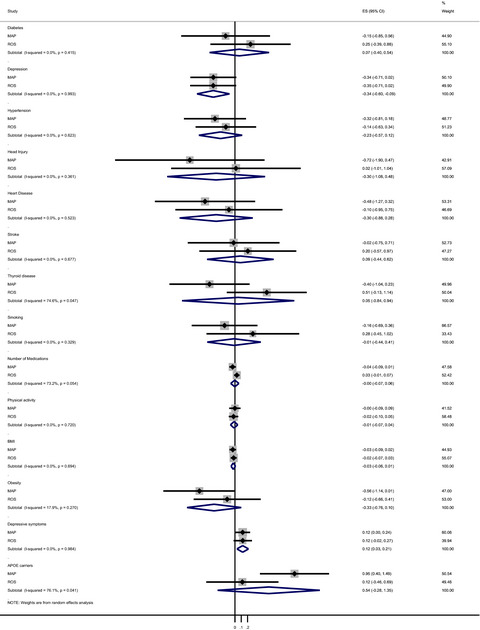
Motoric cognitive risk syndrome (MCR) is a predementia syndrome characterized by cognitive complaints and slow gait. Depressive symptoms, lower cognitive activity participation and presence of apolipoprotein E ε4 allele were identified as predictors of transition to dementia in MCR patients. These findings suggest common pathological mechanisms underlying mood, gait and cognitive declines in aging, which could help develop preventive strategies.
ALS and frontotemporal dementia
Tau protein as a diagnostic and prognostic biomarker in amyotrophic lateral sclerosis
- Pages: 1868-1875
- First Published: 26 February 2021
Chinese validation of the Rasch-Built Overall Amyotrophic Lateral Sclerosis Disability Scale
- Pages: 1876-1883
- First Published: 08 March 2021
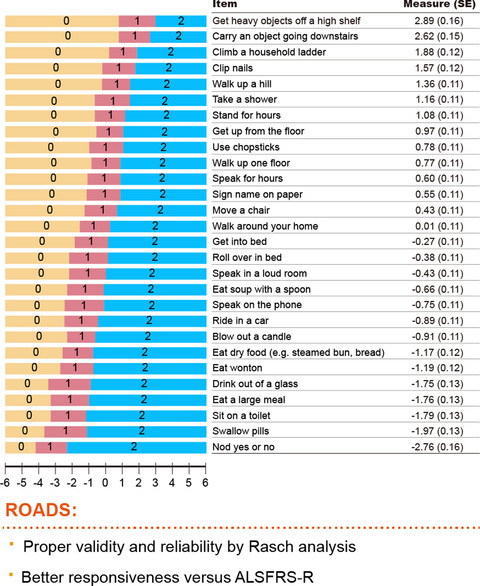
The Chinese version of the Rasch-Built Overall Amyotrophic Lateral Sclerosis Disability Scale (ROADS) was validated by Rasch analysis with proper validity and reliability. It indicates a wider range of item difficulties and better responsiveness than the revised Amyotrophic Lateral Sclerosis Functional Rating Scale. The ROADS could be used as a valuable tool for use in amyotrophic lateral sclerosis trials and in the clinic in Chinese settings.
Movement Disorders
Exploratory pilot study of exogenous sustained-release melatonin on nocturia in Parkinson's disease
- Pages: 1884-1892
- First Published: 11 February 2021
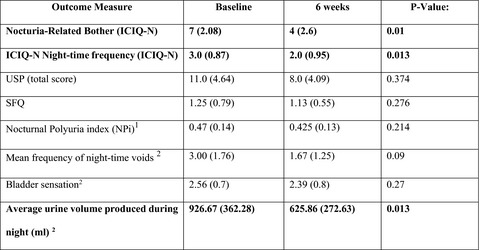
Nocturia can be considered as a form of circadian dysregulation and melatonin can help circadian function and nocturia in Parkinson’s disease (PD). In this open-label, single-site, exploratory, phase 2 pilot study, melatonin 2 mg was administered once-nightly for 6 weeks to adults with PD and nocturia. All patients had standardized urological assessments before and during treatment. In the 20 patients included, there was significant reduction of bother related to nocturia on International Consultation on Incontinence Questionnaire Nocturia (ICIQ-N) (p = 0.01). The number of episodes of nocturia per night (p = 0.013) and average urine volume voided at night (p = 0.013) also improved. No serious adverse events were reported.
Sociability-based fitness approach in Parkinson’s disease: Comparison with conventional rehabilitation
- Pages: 1893-1900
- First Published: 03 March 2021
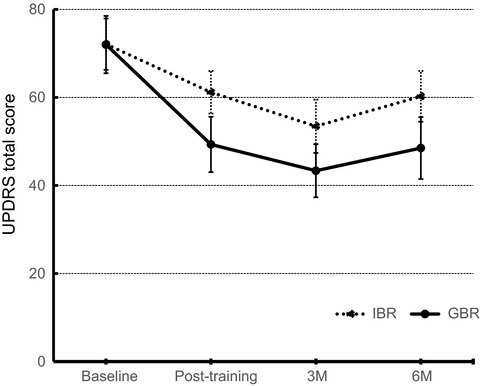
Patients with Parkinson’s disease were randomly assigned to either the group-based rehabilitation (GBR) group (n = 40) or the individual-based rehabilitation (IBR) group (n = 39). The outcome was the difference between the GBR group and the IBR group in the mean change from baseline to post-training in the total score on the Unified Parkinson's Disease Rating Scale. GBR had a more beneficial effect than IBR up to 6 months after training.
Worldwide barriers to genetic testing for movement disorders
- Pages: 1901-1909
- First Published: 17 March 2021
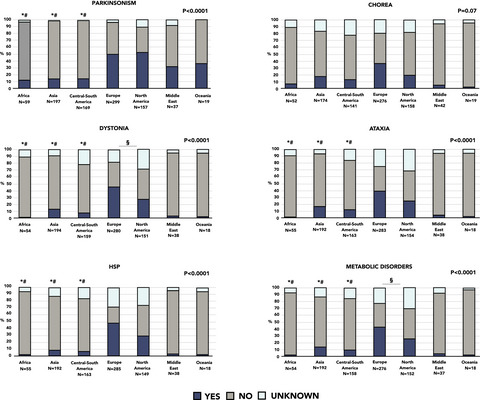
In this online survey designed by the Rare Movement Disorders Study Group of the International Parkinson and Movement Disorder Society, worldwide access to genetic tests for movement disorders and factors impacting their utilization were investigated. Access to geneticists and genetic counsellors as well as to genetic testing for movement disorders was limited at worldwide level, with significant differences in most world regions compared to Europe and North America. Our results highlight major disparities in accessing genetic testing and experts in genetics amongst world regions, probably due to a variety of factors including financial barriers.
Analyses of peripheral blood dendritic cells and magnetic resonance spectroscopy support dysfunctional neuro-immune crosstalk in Tourette syndrome
- Pages: 1910-1921
- First Published: 26 March 2021
Stroke
Magnitude of blood pressure change and clinical outcomes after thrombectomy in stroke caused by large artery occlusion
- Pages: 1922-1930
- First Published: 07 March 2021
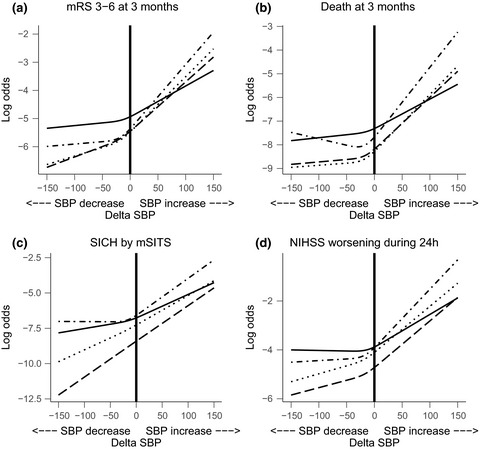
In acute ischemic stroke patients treated with mechanical thrombectomy, systolic blood pressure (SBP) change from baseline is associated with poor functional outcome. The association between SBP change and poor outcome was mostly linear; however, increasingly worse outcomes were observed for increasing SBP.
Correlation between total homocysteine and cerebral small vessel disease: A Mendelian randomization study
- Pages: 1931-1938
- First Published: 29 December 2020
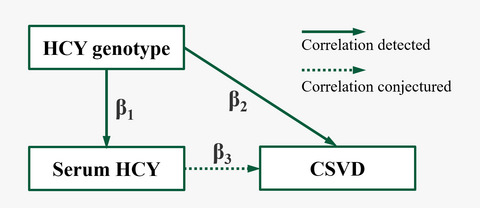
The current Mendelian randomization study found the correlation of HCY with imaging burden of CSVD especially with lacunes and brain volumes loss, and genetic predisposition could facilitate or weaken the correlation. For individuals with risk genetic variants, enhanced HCY lowering strategies might be necessary to reduce the risk and progression of CSVD.
Predictors of perfusion computed tomography alterations in stroke mimics attended as stroke code
- Pages: 1939-1948
- First Published: 20 February 2021
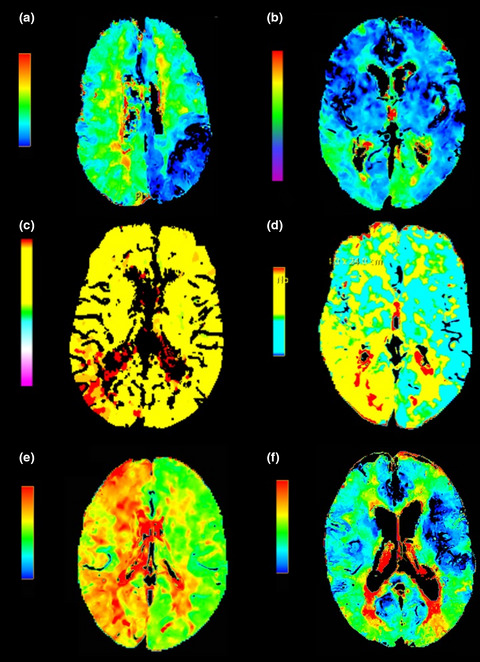
Stroke mimics represent up to 16% of stroke code with a complete multimodal study. The main perfusion computed tomography pattern is alteration of the time to peak map, of unilateral hemispheric distribution or of non-vascular territory. In our series, the independent predictors of alteration in perfusion computed tomography in stroke mimics are aphasia, female sex and older age.
Early apathetic, but not depressive, symptoms are associated with poor outcome after stroke
- Pages: 1949-1957
- First Published: 22 February 2021
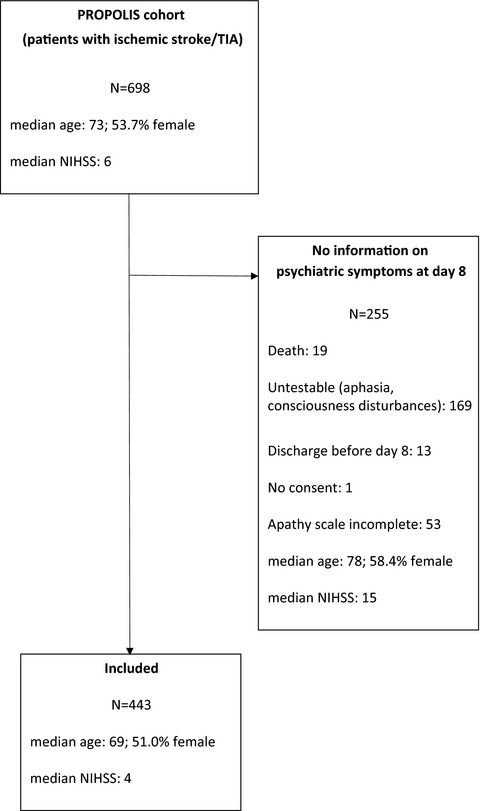
Depressive and apathetic symptoms are frequent neuropsychiatric disturbances after stroke and may appear together. These two symptoms might be associated with different prognoses and benefit from different treatments. Our study showed that apathetic symptoms occurring alone or together with depressive symptoms, but not depressive symptoms that occurred alone, are associated with poor outcome after stroke. Our results underscore the importance of recognizing apathetic symptoms independently from depressive symptoms.
Delirium REduction after administration of melatonin in acute ischemic stroke (DREAMS): A propensity score–matched analysis
- Pages: 1958-1966
- First Published: 03 March 2021
Alterations of brain network topology and structural connectivity-functional connectivity coupling in capsular versus pontine stroke
- Pages: 1967-1976
- First Published: 03 March 2021
Large vessel cardioembolic stroke and embolic stroke of undetermined source share a common profile of matrix metalloproteinase-9 level and susceptibility vessel sign length
- Pages: 1977-1983
- First Published: 07 March 2021
High incidence of stroke in young adults in Tartu, Estonia, 2013 to 2017: A prospective population-based study
- Pages: 1984-1991
- First Published: 08 March 2021
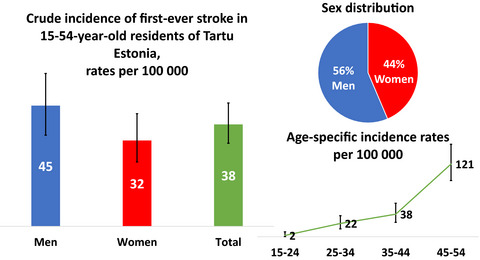
A prospective population-based study was conducted from 2013 to 2017 to determine the incidence and case fatality rate of first-ever stroke in 15- to 54-year-old residents of Tartu, Estonia. We used several overlapping data sources for case ascertainment, and 110 cases were registered (ischemic stroke 72.7%, intracerebral hemorrhage 12.7%, subarachnoid hemorrhage 14.6%). Crude stroke incidence rate was 38/100,000 (95% confidence interval: 31.2–45.8), and the 28-day case-fatality rate was 10.9%.
Apolipoprotein E genotype predicts subarachnoid extension in spontaneous intracerebral haemorrhage
- Pages: 1992-1999
- First Published: 19 March 2021
Cerebral cavernous malformations: Prevalence of cardiovascular comorbidities and allergic diseases compared to the normal population
- Pages: 2000-2005
- First Published: 19 March 2021
Thrombolytic therapy for wake-up stroke: A systematic review and meta-analysis
- Pages: 2006-2016
- First Published: 26 March 2021
Effect of intravenous alteplase on post-stroke depression in the WAKE UP trial
- Pages: 2017-2025
- First Published: 03 March 2021
Multiple Sclerosis
Untreated patients with multiple sclerosis: A study of French expert centers
- Pages: 2026-2036
- First Published: 01 March 2021
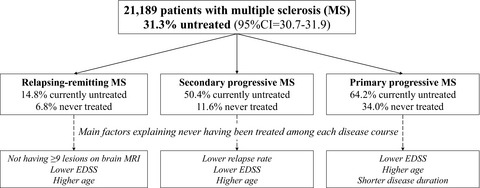
The objectives were to determine the proportion of untreated patients with multiple sclerosis (MS) followed in expert centers in France and to determine the predictive factors of non-treatment. Among the 21,189 patients with MS, 31.3% were not receiving any disease-modifying treatment and the most important predictive factor for not being treated was the disease course: 14.8% of patients with a relapsing-remitting course were untreated, while 50.4% of those with secondary and 64.2% of those with primary progressive MS were untreated. After multivariate analysis among patients with relapsing-remitting MS, the main factors explaining never having been treated were not having ≥9 lesions on brain magnetic resonance imaging and lower Expanded Disability Status Scale score.
Retinal layer thinning predicts treatment failure in relapsing multiple sclerosis
- Pages: 2037-2045
- First Published: 18 March 2021
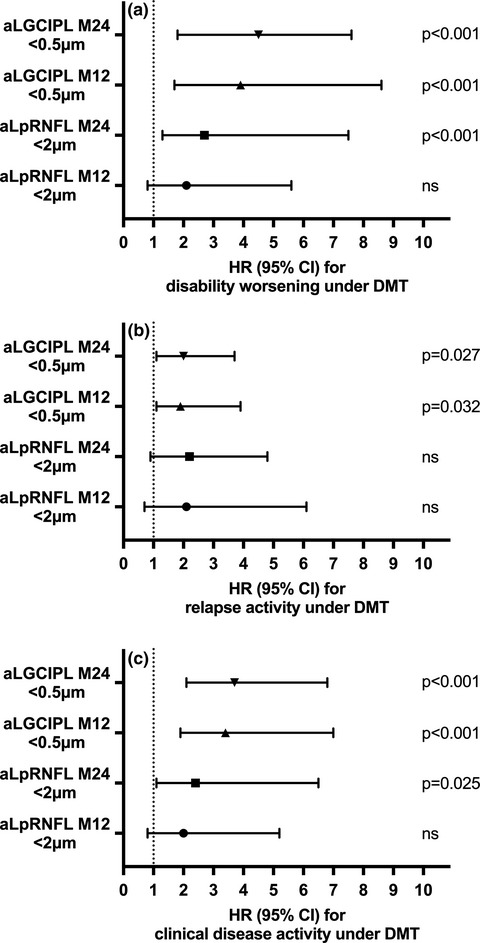
In this 4-year prospective observational study on 113 RMS patients, retinal thinning was investigated for prediction of disease-modifying treatment failure. Thinning of GCIPL and to a lesser degree pRNFL were found to reliably predict disability progression after DMT initiation and may be a useful and accessible biomarker of treatment failure in RMS.
Neuropathies
Cardiovascular health and chronic axonal polyneuropathy: A population-based study
- Pages: 2046-2053
- First Published: 16 February 2021
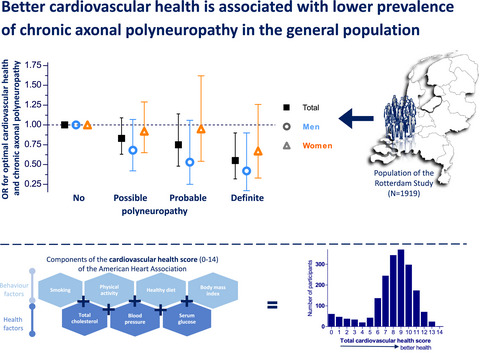
Chronic axonal polyneuropathy is a common, disabling disease for which there is no treatment yet available. This highlights the need to identify modifiable risk factors. In this population-based study, we investigated the association between cardiovascular health, defined by the seven-item American Heart Association score, and chronic axonal polyneuropathy. Better cardiovascular health, consisting of both modifiable health behaviour and health factors, is associated with lower prevalence of chronic axonal polyneuropathy in the general population. This is of interest because individuals can potentially modify their health behaviour.
Association between neuropathy and B-vitamins: A systematic review and meta-analysis
- Pages: 2054-2064
- First Published: 22 February 2021
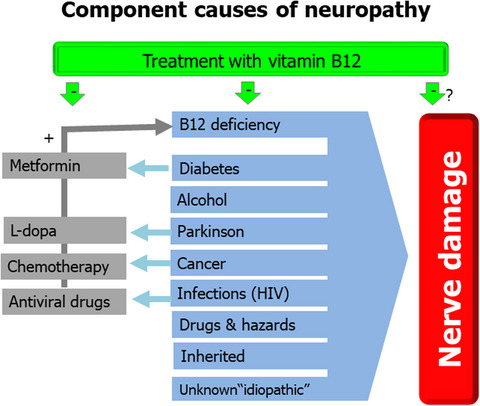
Several component causes of peripheral neuropathy are associated with vitamin B12 deficiency that can itself cause neuropathy. Low plasma vitamin B12 and elevated plasma homocysteine and methylmalonic acid were found to be associated with the presence of neuropathy. Treatment with B12 in patients with neuropathy was associated with only slight symptom improvement.
Misdiagnosis and diagnostic pitfalls of chronic inflammatory demyelinating polyradiculoneuropathy
- Pages: 2065-2073
- First Published: 03 March 2021
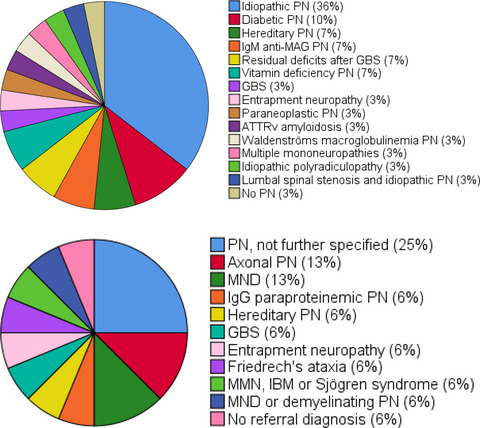
Over- and underdiagnosis of chronic inflammatory demyelinating polyradiculoneuropathy (CIDP) is common. A referral diagnosis of CIDP was revised in 32% of patients (31/96; overdiagnosis). Of 81 patients diagnosed with CIDP, 16 (20%) were referred with another diagnosis (underdiagnosis). Almost all overdiagnosed patients had other forms of neuropathy, while underdiagnosed patients were referred with various neurological disorders. Diagnostic pitfalls included lack of attention to proximal muscle weakness as a diagnostic hallmark of CIDP, insufficient recognition of clinical atypical phenotypes, overreliance on cerebrospinal fluid protein levels, misinterpretation of nerve conduction studies and poor adherence to electrodiagnostic criteria, and failure to exclude other causes of polyneuropathy.
Impact of the metabolic syndrome on peripheral nerve structure and function in type 2 diabetes
- Pages: 2074-2082
- First Published: 07 March 2021
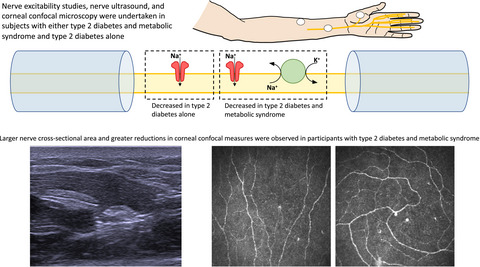
Participants with type 2 diabetes and metabolic syndrome demonstrated more severe changes in nerve excitability measures, which was due to a reduction in sodium channel permeability and sodium–potassium pump function. In contrast, in subjects with type 2 diabetes alone, only sodium channel permeability was decreased. A larger median nerve cross-sectional area and a greater reduction in corneal confocal microscopy metrics were observed in participants with type 2 diabetes and metabolic syndrome.
Muscle and MNJ Disorders
Clinical characteristics and outcomes of thymoma-associated myasthenia gravis
- Pages: 2083-2091
- First Published: 15 March 2021
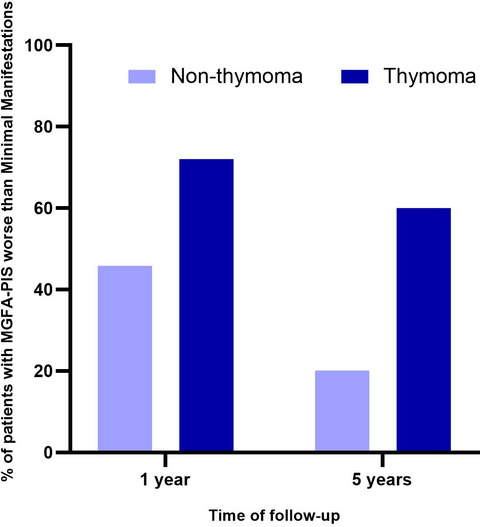
Thymoma-associated myasthenia gravis (MG) patients had more severe myasthenic symptoms and worse prognosis. Thymoma recurrence was frequently associated with transient worsening of MG, but long-term prognosis did not differ from nonrecurrent thymoma. Patients with nonresectable thymoma tended to present severe forms of MG.
Deep phenotyping of an international series of patients with late-onset dysferlinopathy
- Pages: 2092-2102
- First Published: 13 March 2021
Movement Disorders
False-negative tests in Huntington's disease: A new variant within primer hybridization site
- Pages: 2103-2105
- First Published: 11 February 2021
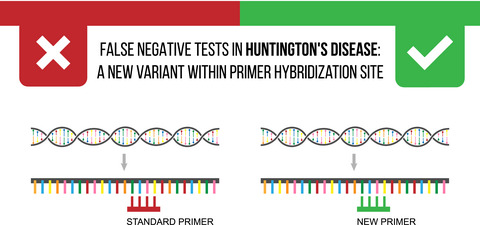
We report a patient with a clinical phenotype suggestive of Huntington's disease (HD), who was repeatedly negative on genetic testing for HD. A newly designed set of primers was used and enabled amplification of the mutant allele and detection of the abnormal range of CAG repeats. As application of the novel primers led to the diagnosis of HD in another five patients who previously tested negative, we propose their incorporation into routine genetic testing in patients suspected to have HD.
Stroke
Endovascular treatment for basilar artery occlusion: A systematic review and meta-analysis
- Pages: 2106-2110
- First Published: 22 January 2021
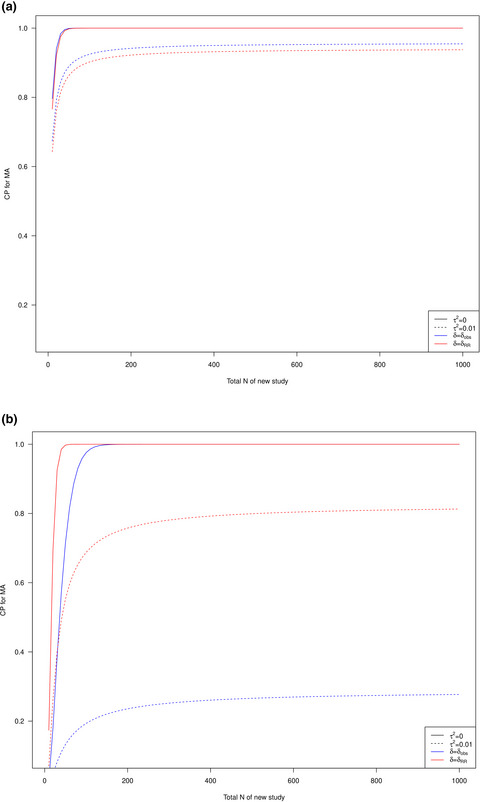
Larger studies are challenged by the perceived lack of equipoise in this vulnerable patient population. Conditional probability analysis suggests that a very small future trial would make a combined significant effect for the outcomes of (a) modified Rankin Scale score 0–3 and (b) all-cause mortality at 3 months in a future meta-analysis almost certain.
Central retinal artery occlusion as a neuro-ophthalmological emergency: the need to raise public awareness
- Pages: 2111-2114
- First Published: 16 January 2021
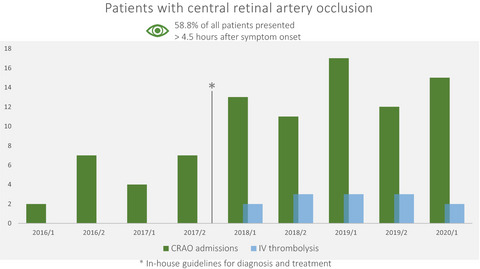
The optimal diagnosis and treatment of patients with central retinal artery occlusion (CRAO) is still controversial. In a retrospective analysis of management pathways of CRAO patients, we observed increased rates of primary stroke admissions from 52.2% to 97.4% and, coinciding with the implementation of in-house guidelines, of intravenous thrombolysis from 0% to 14.1%. Almost 60% of patients presented >4.5 h after symptom onset. Our findings underscore the need to raise public awareness of acute unilateral vision loss as a potential stroke symptom and the joint application of neuro-ophthalmological expertise in managing CRAO.
Multiple Sclerosis
Is the Symbol Digit Modalities Test a useful outcome in secondary progressive multiple sclerosis?
- Pages: 2115-2120
- First Published: 15 January 2021
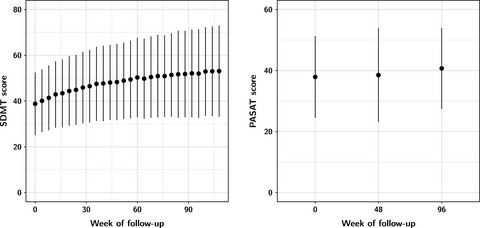
Unexpectedly, Symbol Digit Modalities Test (SDMT) measurements steadily increased during follow-up in a large clinical trial dataset, likely due to a practice effect. The SDMT does not reflect the steady cognitive decline that patients with secondary progressive multiple sclerosis (SPMS) often experience. The SDMT may not be a useful outcome in SPMS clinical trials.
Neuroimmunology
CD8+ T-cell predominance in autoimmune glial fibrillary acidic protein astrocytopathy
- Pages: 2121-2125
- First Published: 16 February 2021
Neuro-oncology
The use of eye-movement recording in patients with anti-Hu antibody–associated paraneoplastic neurological syndromes to objectively determine extent and course of disease
- Pages: 2126-2132
- First Published: 05 March 2021
Neuropathies
Detection of cutaneous prion protein deposits could help diagnose GPI-anchorless prion disease with neuropathy
- Pages: 2133-2137
- First Published: 08 January 2021
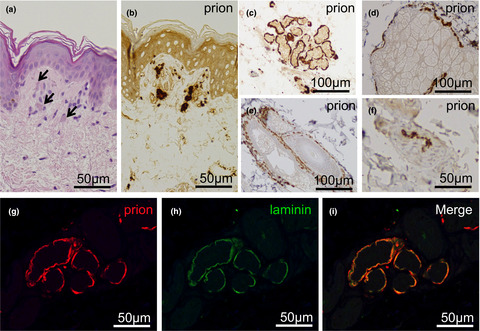
Immunohistochemical detection of prion protein (PrP) in cutaneous samples could be used to definitively diagnose glycosylphosphatidylinositol (GPI)-anchorless PrP disease with neuropathy. The PrP deposits were observed in the dermal papilla (A, B), the eccrine glands (C), the sebaceous glands (D), the hair follicles (E), and peripheral nerves (F) of all examined cases of GPI-anchorless prion disease with neuropathy. The abnormal PrP accumulation was frequently localized at the basement membrane, and colocalized with laminin (G-I: eccrine glands).
Neuropathy of the phrenic nerve associated with antiganglioside antibodies
- Pages: 2138-2141
- First Published: 08 March 2021
Movement Disorders
Letter to the editor in response to the letter from the EPIPARK Study Group regarding the publication ʻProgression of fatigue in Parkinson's disease - a 9-year follow-upʼ (Eur J Neurol 2021. doi:10.1111/ene.14520)
- Pages: e33-e34
- First Published: 05 February 2021
Letter to the Editor about the Ongre et al. publication: ‘Progression of fatigue in Parkinson's disease—a 9-year follow-up’ (Eur J Neurol 2020. doi: 10.1111/ene.14520)
- Pages: e35-e36
- First Published: 18 January 2021
Stroke
Response to Carvalho et al.: Diagnosis of monogenic small-vessel disease – “real- world” application of the consensus recommendation of the European Academy of Neurology
- Page: e37
- First Published: 10 March 2021
Diagnosis of monogenic small vessel disease—“real-world” application of the consensus recommendation of the European Academy of Neurology
- Pages: e38-e39
- First Published: 12 March 2021
Neuropathies
Minimal detectable change and minimal clinically important difference in spinal muscular atrophy patients
- Pages: e40-e41
- First Published: 19 February 2021
Reply to: Minimal detectable change and minimal clinically important differences in spinal muscular atrophy patients
- Pages: e42-e43
- First Published: 12 March 2021




